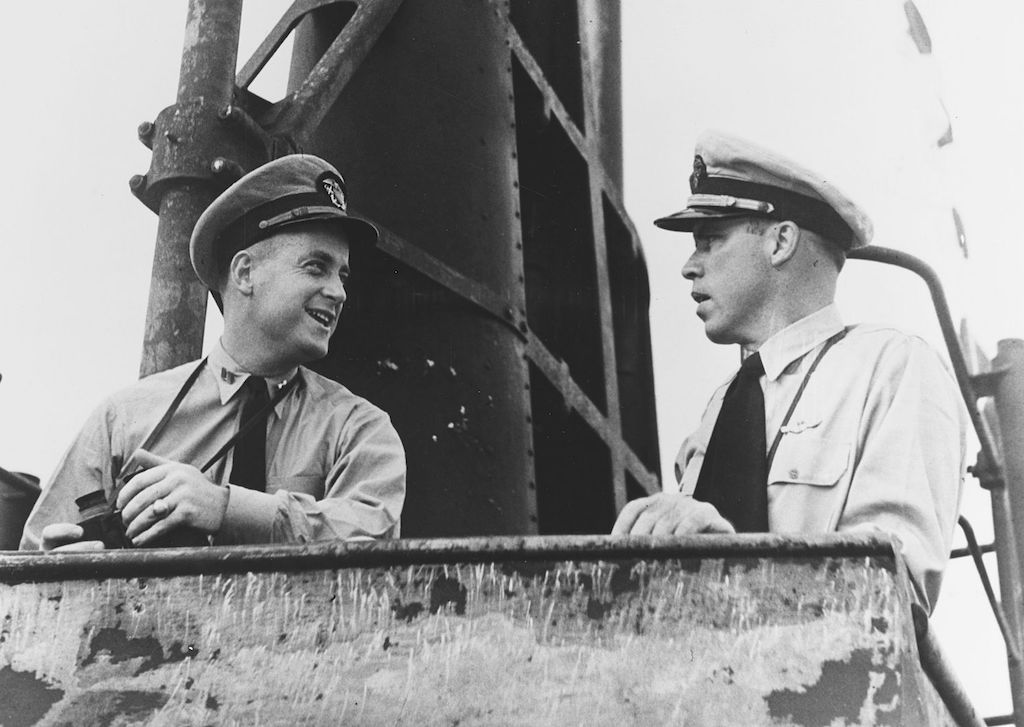The most successful submarine commander ever was captured by the Japanese

O’Kane (left) speaks with his commanding officer, Dudley Morton, on the bridge of the Wahoo c. February 1943.
SUMMARY
When Rear Adm. Richard O’Kane retired from the Navy in 1957, he was (and still is) the most successful American submarine commander, ever. A graduate of the U.S. Naval Academy, he spent his entire wartime career sinking enemy ships. By the end of the war, he would receive three Navy Crosses, three Silver Stars and the Medal of Honor. The only thing that could stop him was his own faulty torpedo.
O’Kane started his career on surface ships, but qualified for submarine duty in 1938, and it’s a good thing, too. His skill in the “silent service” would help the United States win the war in the Pacific Theater. After the U.S. entered World War II, he joined the crew of the USS Wahoo, a legendary submarine in its own right. There, he learned everything he needed to know about captaining a sub from an equal submariner legend, Lt. Cmdr. Dudley Morton.
On his five patrols with the Wahoo, the boat wreaked havoc on Japanese shipping and naval movements. In July 1943, O’Kane was promoted and given command of the USS Tang, the sub that would propel him into U.S. Navy legend. In command of his own crew, he drilled them relentlessly in acquiring the range of targets swiftly and accurately. It would come in handy in combat.
In Tang’s five patrols, O’Kane and crew would sink 33 ships for almost 118,000 tons of shipping, making it the most successful submarine of the war. The first patrol sank three freighters in a daring nighttime surface attack, evaded the enemy and then followed the remaining ships until morning, when it hit them again from below the surface. In evading after the second strike, Tang had to dive below its maximum depth. Its second patrol saw the rescue of 22 downed airmen, earning the boat a Presidential Unit Citation.
Its third patrol sank more enemy ships than any other single patrol of the war, beating the previous record, which happened to belong to the USS Wahoo, where O’Kane was the Executive Officer. Its fourth patrol took the Tang to the Japanese home waters, where in little more than a month, it expended all its torpedoes sinking freighters, tankers, and patrol boats before returning to Pearl Harbor.
USS Tang’s fifth and last patrol sent it to the Formosa Strait, near modern-day Taiwan. After its departure, however, no one heard from Tang again. The only reason we know what happened to it came from the very few survivors. In October 1944, Tang attacked a large convoy of Japanese freighters, transports, and escort ships. Expending nearly all its torpedoes, it sank two large freighters in the convoy.
As it fired its final Mark-18 torpedo from its aft tubes, the shot curved as the submarine fishtailed to avoid the torpedo’s return. The move failed and Tang was hit in its aft torpedo room by its own shot. The explosion racked the boat, and the sub began to sink. The bridge crew escaped by swimming to the surface, others used the forward escape trunk. Seventy-eight crew members were killed.
O’Kane and eight others escaped only to be “rescued” by a Japanese frigate, one of the ships the crew had been targeting the night before. The Japanese sailors beat the Americans mercilessly before sending them all, including O’Kane, to a prisoner of war camp near Yokohama. He would spend the remainder of the war imprisoned there.
The Tang was lost, but its commander would survive the war and continue his Navy service until 1957. He died in 1994, but to honor his memory, the oldest fast attack submarine in the U.S. Navy carries his personal cribbage board. It’s currently aboard the Los Angeles-class submarine USS Chicago.
READ MORE ON WATM:
SHARE
